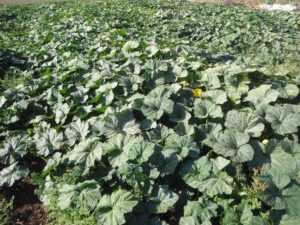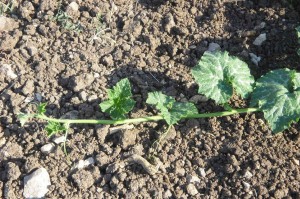
Last week we told you about the probiotic food workshops hosted by Eliezer of Shorshei Zion, which gives us a great opportunity to tell you more about Eliezer’s unique endeavor in preparing “living foods.” In his workshops, Eliezer teaches how to prepare food that contains probiotic bacteria which contribute to the healthy, efficient activity of the digestive system. In a small factory in Beit Shemesh, he produces crackers, assortments of nuts, almonds and sunflower seeds, special gRAWnola made of buckwheat seeds, vegetable chips in an assortment of flavors, and even chocolates and desserts.
Eliezer makes all of the above as living food, i.e., by drying it or baking at a very low temperature so as not to harm the vitamins contained in the fruit, vegetables and nuts. In addition, he uses components that boast many nutritious values, including special berries such as Goji, Açaí, Spirulina algae, bee pollen, raw cocoa and more. You can find a detailed description of Eliezer’s excellent, unique (and delicious) products in our order form.
____________________________________
Manu, our baker par excellence whom many of you were lucky to meet at the Sukkot Open Day, is now introducing a new bread product. Since organic flour breads are quite pricey due to the high cost of flour, Manu now offers a less expensive, high-quality bread, homemade with her special ingredients of love and skill. This is non-organic whole wheat bread, 10% rye flour, at 18 NIS. Manu’s entire line of delectable loaves may be ordered via our order system.
___________________________________________
Expanding Chubeza’s Delivery Line to the Ono Valley
Following a great deal of preparation, we proudly introduced a new delivery line last week to the Ono Valley area: Ramat Efal, Kiryat Ono, Yehud-Monesson, Ganei Tikvah and Savyon. For now, these deliveries are once per fortnight. May we enjoy success!
__________________________
The Next of (Pump)kin
She’s been riding along in our boxes for some months now, loyal, sweet and nutritious. She does it every year, at the precise time when summer vegetables are slowly disappearing while winter veggies have only just begun to surface. And yet, we have hardly written about her nor sung her praises. So today, allow me to shed a new light upon the vivid orange slice of pumpkin in your box.
I don’t know why humankind thinks the apple was the forbidden fruit in the Garden of Eden. I’m pretty sure that all clues lead instead to the pumpkin. First and foremost, a pumpkin patch can easily look like a piece of jungle: a thick stem sending its roots anywhere it touches the earth, huge leaves protecting the fruits and enormous glamorous yellow flowers. Secondly, the pumpkin abounds with the highly beneficial yellow-orange pigment “lutein,” renowned as the main antioxidant protecting the eye, so it comes as no surprise that this fruit was an eye-opener for Adam and Eve. And finally, as it was a pumpkin, huge and overwhelming like pumpkins can be, it’s no wonder Eve couldn’t clean her plate and had to invite Adam to take a bite or two…
This Garden of Eden is most probably located in Mexico, the site from which our pumpkins originated. The farmers of Central America raised pumpkins for thousands of years. Except they did not use them for food. Pumpkins of old were used for their seeds, as a canister, as instruments of music and ritual and in the production of weaving mats (from slices of dried-up pumpkin peels). The reason for this abstention from consumption was not due to a moral learned from the Fall from Eden, but rather the simple fact that it was not tasty or easy on the tongue, for the first pumpkins were quite fibrous and very bitter.
Today too, most of the pumpkins that grow in America are inedible, and aimed specifically for the special rituals of Halloween. The origins of this rite of pumpkin go back to an Irish myth that featured a turnip, not even a pumpkin (in accordance with the cold Ireland climate.) The story tells of the miserly Jack, an alcoholic no-gooder who deceived the devil, exacting from him a promise that he would not take his soul to hell upon Jack’s death. However, when Jack died there was no place for him in heaven either, thus poor Jack was doomed to a life of wandering, holding a piece of burning ember to light his way, which he placed inside a hollow turnip. The Irish used to prepare Jack’s lantern by carving a scary face into a turnip, potato or beet, aimed to scare away the restless Jack. When the Irish immigrants arrived in North America, they discovered pumpkins and turned them into Jack’s lantern, otherwise known as Jack o’lanterns!
In a different American autumn tradition, the pumpkin stars as a main component for the grand Thanksgiving Day meal. Today’s pumpkin pie is made from pumpkin pulp, but the original pie was really a headless pumpkin, seeded and filled with milk, honey and spices and baked upon hot embers.
The most famous magical pumpkin is Cinderella’s, whose garden pumpkin was transformed to a magical coach, but there is also a Chinese tale about an old doctor who arrived to a city carrying a remedy that could heal every type of disease. He opened a pharmacy, and hung a pumpkin peeling outside his door. Every evening, after the sun set, the doctor would disappear suddenly from his pharmacy, leaving behind an empty store and a pumpkin peel. No-one knew his whereabouts. After some time, a clerk found out the old man’s secret: at the end of each day, after sunset, the old man would jump into the pumpkin peel. The clerk made friends with the old man and was invited in to the pumpkin getaway, where he discovered an enchanted world.
But the pumpkin does not belong only to exotic traditions and nostalgic tales. Like the immortal creature it is, the pumpkin maintains its charm, roly-poly grace, and timeless intrigue. If Cinderella is my immediate association with pumpkin, my 10-year-old Neta dreams of gobbling pumpkin cookies and drinking pumpkin juice in magical meals she attends alongside Harry Potter.
And there’s a good reason for that: the pumpkin is a very easy vegetable to digest, with a very low caloric content. Great for babies, kids and adults.
The Chinese believe the pumpkin eases depression and soothes digestion by working on the spleen and stomach. In the West, it is claimed that pumpkin seeds help heal diseases and urinary tract infections. Alternative medicine sings the pumpkin’s praises for preventing constipation, cold-related ailments, and even in relieving allergic reactions. Oil extracted from pumpkin seeds is used to treat prostate cancer.
Every part of the pumpkin is edible, including the stems, leaves and soft roots, which are used in Italy in omelets or soup. The flowers are great for stuffing or to toss into a salad or risotto. And of course, the pulp goes with any dish you may be cooking up. Even the rind is edible. In southern Italy, specifically in Calabria, residents used to dry pumpkin rinds in summer. Throughout the winter, they would soak these peels, coat with flour, and then deep fry.
Remember how we started out discussing pumpkins grown for their seeds? Well, today, too, this is the case. Even bitter fibrous pumpkins make delectable seeds. Pumpkin seeds are also very healthy, rich in unsaturated fatty acids as well as zinc. Austria has been known for producing the best pumpkin seed oil for 300 years now, which they prepare by growing a special type of rind-less pumpkin with seeds, a pumpkin that appeared from nowhere around the year 1870, probably the result of a mutation of a unique genetic coincidence.
.

We grow various types of small pumpkins, but our great big tremendous one is seeded in wide spaces (2-3 meters) in order to allow plenty of growing room, as each pumpkin plant can reach the length of up to 9 meters! We seed it in March, sometimes even at the end of February, and wait patiently for 4-5 months till it ripens and changes color to light cream. The pumpkins, some of which are enormous, are gathered from the field to be stored in our shed. This year we actually built them their own storage shed with net shades, so we can place them alongside one another and allow them some post-harvest breathing space, prolonging their lifespan.
Some magic that can be created with pumpkins:
Cooking in water, only if you’re making soup. The water will be rich in vitamins, minerals and yummy pumpkin flavor. Slice pumpkin into pieces and cook in boiling salted water. Having difficult cutting it? Cook the pumpkin in its shell, which will then slip off easily after cooking.
Steaming if you wish to soften the pumpkin, steaming is better than cooking. Place equal-size slices in a steamer over boiling water.
Baking in the oven, this way the pumpkin is softened without adding liquid. If towards the end of your baking you remove the cover, the excess water will totally evaporate.
Frying a firm mealy-textured pumpkin is suitable for the preparation of chips (fries) or to coat with flour and fry.
Grill cube or slice pumpkin, brush with olive oil and grill on all sides till brown and soft.
Storage:
A whole pumpkin can be stored for months in a cool place (but not too cool, under 8 degrees). A sliced pumpkin can be refrigerated for 3 days, wrapped well. A cooked pumpkin (regardless of the cooking method) can be frozen for up to 3 months.
Flavors that go well with pumpkin:
Almost everything – spicy, salty, sweet: black pepper, nutmeg, a combination of ginger, garlic and soy. Curry, fresh herbs: rosemary, sage and bay leaves. Cinnamon, cloves, anise, coconut milk, date honey.
I spoke with Noga about the pumpkins and she sent me this great recipe with a recommendation to add walnuts – enjoy!
Pumpkin, Sage, and Browned-Butter Quick Breads
Wishing you peaceful days of autumn and changing-season, with hope that the quiet returns, along with calm and reconciliation.
Shavua Tov,
Alon, Bat Ami, Dror, Yochai and the entire Chubeza team
_______________________________
WHAT’S IN THIS WEEK’S BOXES?
The tomato plants have started to yield once more! Although the quantities are still too limited to cover the full Chubeza roster, at least some of you will receive these ruby-red gems in this week’s boxes. All going well, we look forward to soon restoring red tomato glory to each and every salad!
Monday: Lettuce, parsley/coriander/dill, slice of pumpkin, red/green bell peppers, leeks/scallions, Swiss chard, cucumbers, sweet potatoes, baby greens (mesclun mix). Small boxes: radishes, potatoes.
Large box, in addition: Arugula/tot soi, Thai beans/ okra/Jerusalem artichokes, eggplant, corn, potatoes/tomatoes.
Wednesday: Lettuce, parsley/coriander/dill, slice of pumpkin,leeks/scallions/garlic chive, Swiss chard, cucumbers, sweet potatoes, baby greens (mesclun mix). radishes, Jerusalem artichokes, Small boxes: potatoes.
Large box, in addition: red and green bell peppers/potatoes, arugula/mizuna/mustard greens, Thai beans/ okra, eggplants/tomatoes.
And there’s more! You can add to your basket a wide, delectable range of additional products from fine small producers: flour, fruits, honey, dates, almonds, garbanzo beans, crackers, probiotic foods, dried fruits and leathers, olive oil, bakery products and goat dairy products too! You can learn more about each producer on the Chubeza website. Our order system also features a detailed listing of the products and their cost. Make an order online now!


